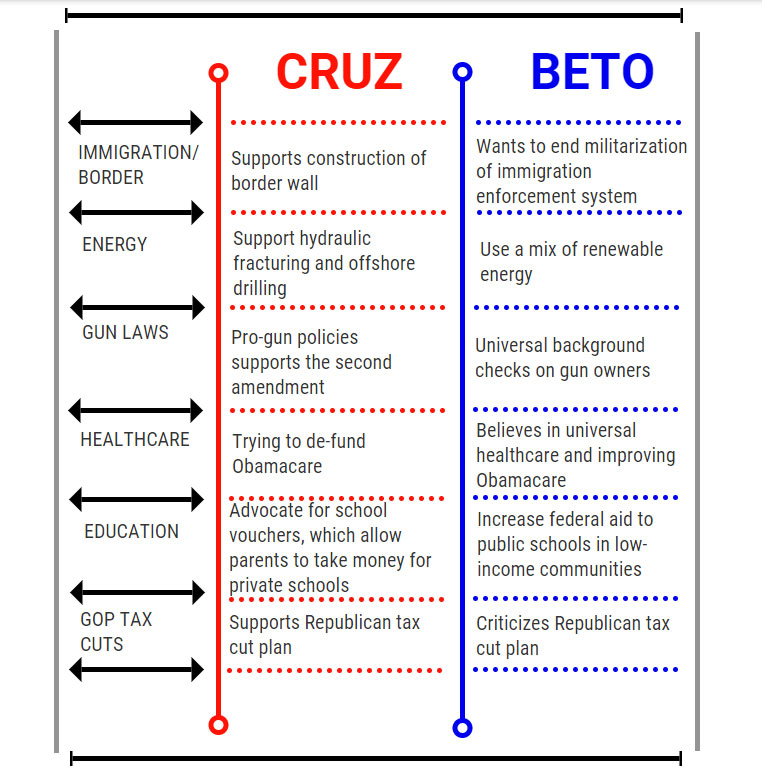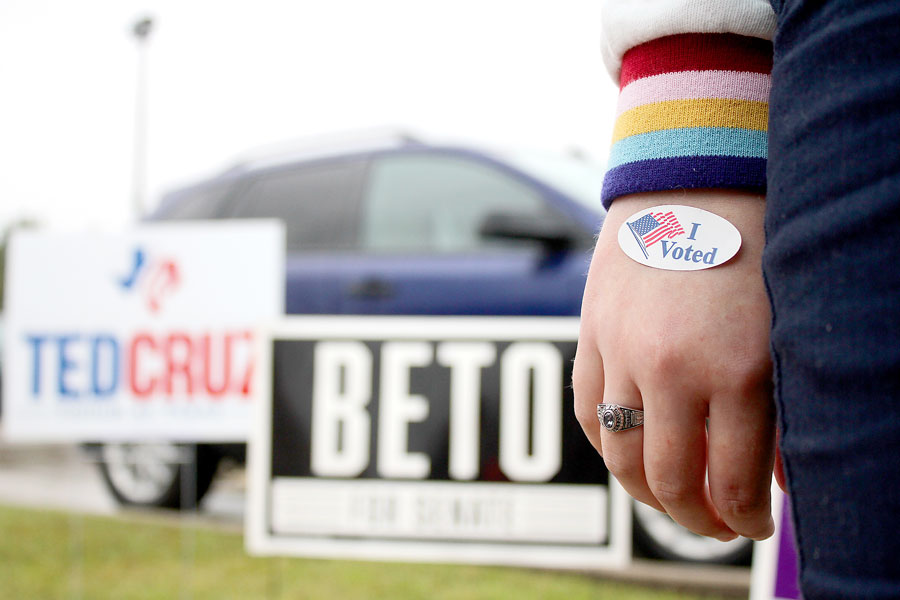The battle for Texas
Students and teachers discuss political activism and awareness
November 1, 2018
As Nov. 6 draws near, the topic of the midterm elections, including the race for Senate is gradually dominating social media and yard signs. With polls too close to predict a clear winner, Texas qualifies as a battleground state for Senate.
Early voting began Oct. 22 and will continue to Nov. 2. Additional information regarding the midterm elections can be found on www.votetexas.gov/voting.
With critical roles of the Senate, including the power to veto and hold trials for impeachment, senators that are elected to represent each state can ultimately determine how some critical decisions will be made at the federal level.
Representing the Republican Party is incumbent Ted Cruz, 47, who has been the junior senator from Texas since 2013 and ran as a candidate for the Republican nominee for the 2016 presidential election. Challenging Cruz for his seat, is Democrat Robert (Beto) O’Rourke, 46, who has been serving as a congressman since 2013.
Recent events concerning the younger generations of the country, like the March For Our Lives, Me Too and Black Lives Matter, have led much of the youth to become politically active; inspired by those events, students have held two voter registration drives on campus since then, registering about more than 200 students. Their voter turnout in these upcoming elections can potentially sway the results of the election.
“I’m particularly eager to see young voters get involved because I think a lot of people over the past decades have thought that not voting was remaining neutral or not doing any harm,” debate coach Leann Solice said. “The apathy that comes from not voting means people who seek political power are given free reign because then they don’t have to meet your expectations, they don’t have to address your issues and they kind of get a free pass from you.”
In a random online poll conducted during the advisory period, 627 students out of 1,018 — 62 percent — said if they were eligible to vote, they would give their vote to O’Rourke.
“I think [Beto] is a better candidate because [he] is more well-versed and tries to appeal to everyone, whereas Ted Cruz is just trying to appeal to the white Christian older generation who [is] going to vote for a more conservative person for Texas,” senior Rachel Gray said.
When compared to the national scale of party affiliation, students at Hebron yielded greater support for the Democratic party, 36 percent, as opposed to the Gallup Poll’s national poll results of 27 percent.
“When you are young, and this is a generalization, I think you are typically more idealistic,” AP Government teacher Travis Fitzgerald said. “Then as you get older, you might start to get more fiscally conservative as you are trying to become self-sufficient [since] there’s a lot more that you look at.”
Despite the left-leaning majority among students, about 40 percent of students would give their vote to Cruz, mainly for his economic policies.
“He has very limited government intervention in economics, and also opposes the tariffs Trump placed, which is something I also disagree with,” junior Chance Kauffman said. “I don’t think that with younger voters Cruz really has anything. Most of them vote on mostly social issues, from what I’ve seen, and I’m the first to say that Cruz’s social policy is lacking. Beto definitely has him beat there.”
Some students, however, are more moderate and have a difficult time deciding between the two candidates.
“I like Cruz’s stance on education: he supports school choice and an end to Common Core,” junior Robert Valecka said. “The ability to choose is very valuable and options between different types of schools and different types of learning are just that. [And] I appreciate O’Rourke’s proposed background checks for all gun sales. I think both sides can agree that background checks can only do good when it comes to such dangerous weapons.”
Though Valecka said he doesn’t clearly support one candidate over the other, he thinks Cruz has a better chance of winning the election.
“Cruz is the name that everyone knows,” Valecka said. “While some voters, especially the ones in the more secluded areas of Texas, know little of O’Rourke. Cruz has the past publicity and the present publicity from his performance in the debates. It’s an uphill battle for O’Rourke on multiple fronts.”
Although about 60 percent of the students said they would vote Democrat, if old enough, when it comes to party affiliation, the majority of students, 39 percent, said they didn’t identify with either the Democrat or Republican party.
“[With] the political parties now… [there’s] this increasing polarization,” Fitzgerald said. “You have to adhere to the party line so it makes sense that people are picking and choosing and I think that’s great, I think that the educated voter should look at things by a case-by-case policy issue and not be sworn to a party.”

Though Fitzgerald said he has not noticed party realignment among students over the years, he has noticed an increase in activism and participation in politics.
“The silver lining to the age of Trump, regardless of where you stand on, is that people are active politically,” Fitzgerald said. “Eight or nine years ago, we would talk about something [in class] and there weren’t a lot of current examples to pull from. [Now,] there’s more activism, people are interested [and] talk about politics more. I’ve had students recently that are huge political science nerds that follow everything.”
Among the ways students have been politically active, the most common forms of participation, according to the survey responses, were attending marches and protests and signing petitions.
“I’ve been to the Women’s March, the March For Our Lives rallies and I’ve been to the town hall with the Road to Change,” Gray said. “I’ve [also] signed petitions and helped with the register to vote drive through JSA, and I just try to get the word out there. [Because] social media affects people, I try to retweet points from the debates and I try to spread the word and make sure people are informed about voting.”
About 60 percent of students surveyed said they don’t feel well-informed regarding the midterm elections, and voter turnout of young voters in the 2014 midterm elections, 17 percent, was significantly less than the turnout for the 2012 presidential elections, 41 percent. Solice said these upcoming elections are just as important for students to participate in.
“I know it’s exciting to vote for president because it’s the big top of the ticket thing that everybody talks about,” Solice said. “But what senator you have has more of a role in whether or not there’s funding for your theater program or your soccer cleats or your new camera for the journalism department than anything that happens on the national stage. I would love to see young voters inform themselves and then go vote for the candidate that gives them what they want.”
Fitzgerald said students should learn to participate like older voters who have had turnout rates of about 70 percent in the presidential elections and 50 percent in the midterm elections,
“Younger people need to think like older people,” Fitzgerald said. “If [someone] loses the [election], the thing is not to be discouraged and then go back to ‘Fortnite.’ Older voters don’t think like that; they think long term and that’s why there’s much more attention paid to Social Security than student loan debt. Until that changes, politicians aren’t going to care.”
